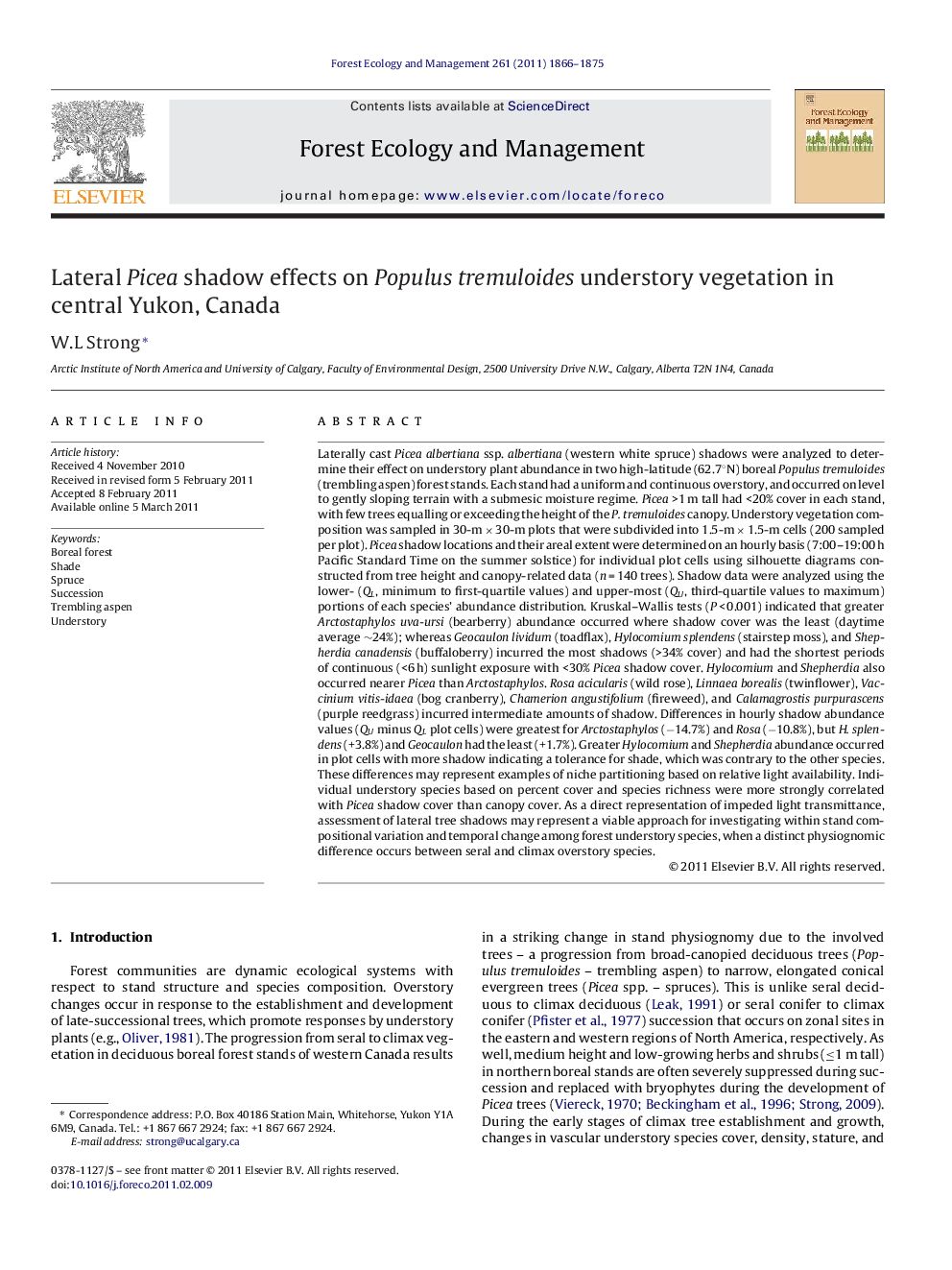| کد مقاله | کد نشریه | سال انتشار | مقاله انگلیسی | نسخه تمام متن |
|---|---|---|---|---|
| 87875 | 159270 | 2011 | 10 صفحه PDF | دانلود رایگان |

Laterally cast Picea albertiana ssp. albertiana (western white spruce) shadows were analyzed to determine their effect on understory plant abundance in two high-latitude (62.7°N) boreal Populus tremuloides (trembling aspen) forest stands. Each stand had a uniform and continuous overstory, and occurred on level to gently sloping terrain with a submesic moisture regime. Picea >1 m tall had <20% cover in each stand, with few trees equalling or exceeding the height of the P. tremuloides canopy. Understory vegetation composition was sampled in 30-m × 30-m plots that were subdivided into 1.5-m × 1.5-m cells (200 sampled per plot). Picea shadow locations and their areal extent were determined on an hourly basis (7:00–19:00 h Pacific Standard Time on the summer solstice) for individual plot cells using silhouette diagrams constructed from tree height and canopy-related data (n = 140 trees). Shadow data were analyzed using the lower- (QL, minimum to first-quartile values) and upper-most (QU, third-quartile values to maximum) portions of each species’ abundance distribution. Kruskal–Wallis tests (P < 0.001) indicated that greater Arctostaphylos uva-ursi (bearberry) abundance occurred where shadow cover was the least (daytime average ∼24%); whereas Geocaulon lividum (toadflax), Hylocomium splendens (stairstep moss), and Shepherdia canadensis (buffaloberry) incurred the most shadows (>34% cover) and had the shortest periods of continuous (<6 h) sunlight exposure with <30% Picea shadow cover. Hylocomium and Shepherdia also occurred nearer Picea than Arctostaphylos. Rosa acicularis (wild rose), Linnaea borealis (twinflower), Vaccinium vitis-idaea (bog cranberry), Chamerion angustifolium (fireweed), and Calamagrostis purpurascens (purple reedgrass) incurred intermediate amounts of shadow. Differences in hourly shadow abundance values (QU minus QL plot cells) were greatest for Arctostaphylos (−14.7%) and Rosa (−10.8%), but H. splendens (+3.8%) and Geocaulon had the least (+1.7%). Greater Hylocomium and Shepherdia abundance occurred in plot cells with more shadow indicating a tolerance for shade, which was contrary to the other species. These differences may represent examples of niche partitioning based on relative light availability. Individual understory species based on percent cover and species richness were more strongly correlated with Picea shadow cover than canopy cover. As a direct representation of impeded light transmittance, assessment of lateral tree shadows may represent a viable approach for investigating within stand compositional variation and temporal change among forest understory species, when a distinct physiognomic difference occurs between seral and climax overstory species.
Research highlights
► Lateral Picea shadows influence Populus understory vegetation composition.
► Arctostaphylos uva-ursi was least shadow-tolerant of nine assessed understory species.
► Hylocomium splendens and Shepherdia canadensis were the most shadow-tolerant species.
► Picea shadows were a better predictor of understory differences than canopy cover.
► Understory succession was more a function of Picea abundance than stand age.
Journal: Forest Ecology and Management - Volume 261, Issue 11, 1 June 2011, Pages 1866–1875